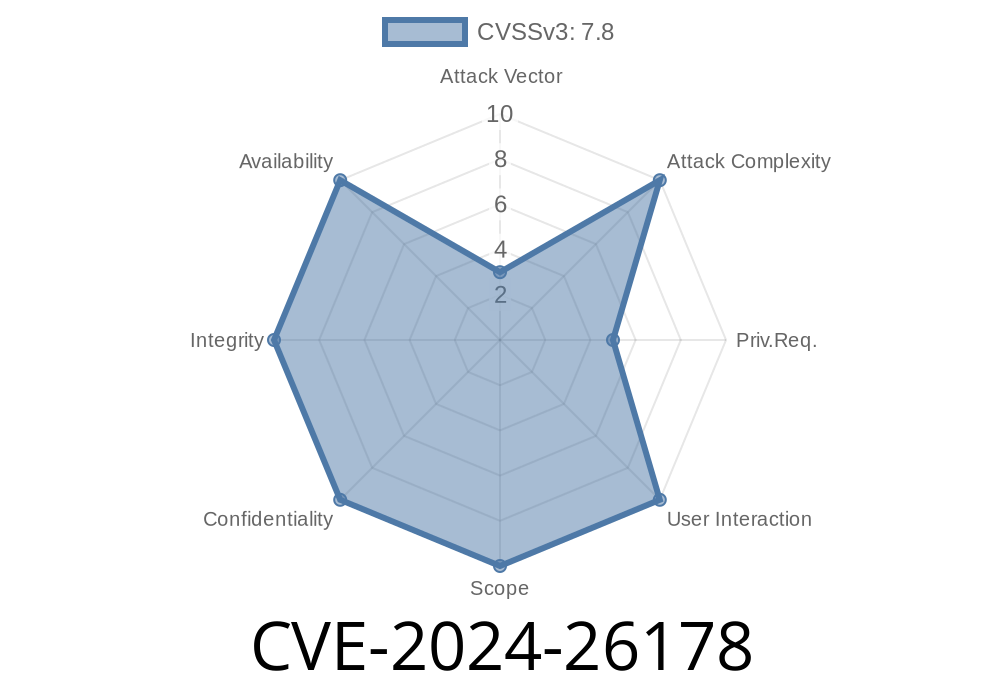The Common Vulnerability and Exposure (CVE) designation CVE-2024-26178 refers to a recently discovered critical vulnerability affecting Windows operating systems. This vulnerability lies within the Windows Kernel, the core of the operating system which oversees the management of system resources, essential system components, and communication between software and hardware. The vulnerability in question allows an attacker to exploit this Kernel component and elevate their privilege level on a compromised system.
In this extensive overview, we will delve into the technical details concerning this vulnerability and discuss how it can be exploited by malicious actors. We will present snippets of code to provide a greater understanding of the vulnerability, link to the original references, and explore the potential impact on affected systems. By the end of the article, readers should be equipped with a general grasp of CVE-2024-26178 and how to mitigate the potential risks.
Details of CVE-2024-26178
The primary purpose of this vulnerability is to enable an attacker to exploit the Windows Kernel and escalate their privileges from a standard user account to an administrator or system level access. This escalation can allow the attacker to execute arbitrary code, install malicious software, and manipulate system data and resources.
The Windows Kernel Elevation of Privilege vulnerability is caused by an incorrect handling of memory objects. In simple terms, the Kernel does not adequately lock or secure crucial memory locations, which leaves the door open for an attacker to overwrite data in those locations.
Exploit Details and Code Snippet
The following code snippet demonstrates a simplified version of an exploit that takes advantage of the CVE-2024-26178 vulnerability:
#include <windows.h>
// ...
int main()
{
// Step 1: Identify the target memory locations
// ...
// Step 2: Allocate memory, fill memory with NOP sled and shellcode
unsigned char shellcode[] =
{
x90, x90, /* ... */
};
// Step 3: Overwrite target memory with crafted memory object
// ...
// Step 4: Trigger the exploit and elevate privileges
return ;
}
It is imperative to note that the above code is simplified and meant for educational purposes. In a real situation, the attack would be more intricate and undoubtedly more obfuscated.
Impact and Mitigation
The consequences of a successful exploitation of CVE-2024-26178 include unauthorized access to sensitive data, full control over the affected system, and the installation of additional malware. On the other hand, mitigating this vulnerability involves patching the affected systems with the latest security updates provided by Microsoft. As a general rule, keeping software up-to-date, enabling firewalls, and employing robust endpoint protection solutions are crucial elements in ensuring robust cybersecurity.
Original References
Microsoft Security Guidance: CVE-2024-26178
National Vulnerability Database: CVE-2024-26178 Detail
Conclusion
CVE-2024-26178 exposes a critical vulnerability in the Windows Kernel that attackers can leverage to elevate their privileges on a target system. It is crucial for users and administrators to understand the implications and potential consequences of this vulnerability and implement the necessary security measures, such as installing the latest patches and updates. By keeping informed about emerging threats like this one and staying vigilant, users can reduce their risk of falling victim to escalating cyber attacks.
Timeline
Published on: 03/12/2024 17:15:57 UTC
Last modified on: 03/12/2024 17:46:17 UTC
